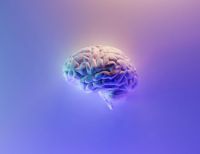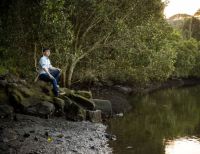
Lead author Dr Matthew Davidson.
This study extends earlier work from the same lab showing that perception of vision and sound is cyclic, with our brain taking around eight samples per second.
Professor Alais said: “The critical new finding in this study is that these oscillations in the brain’s sampling of the world slow down when walking to match the step cycle.
“Humans take about two steps per second when walking and generally keep to a consistent rhythm. The reported oscillations in visual sensitivity also occur at about two cycles per second and are locked to the step cycle. In some participants these rhythmic oscillations occur at four cycles per second but these were also locked to the step cycle.”
This work is the first time that visual perception has been finely and continuously sampled during walking. Without virtual reality headsets and motion tracking it would not be possible.
Dr Davidson said: “Thanks to VR technology we have discovered that our vision moves through a good and a bad phase on every step.”
It is unclear why our brain’s perceptual processes are so closely linked to walking.
Professor Alais said: “One possible explanation is that vision becomes secondary to motor control while your foot is grounded and the next step is planned. Once you are in the swing phase between footfalls, the brain switches back to prioritising perceptual sampling of the world, creating an ongoing perceptual rhythm that harmonises with your step rate.”
The findings open questions that the research team will pursue in further studies. For example, does perception of sound and touch also modulate as we walk? And what about neural activity?
The research team plans to follow up these questions to further understand the implications.
Dr Davidson said: “An obvious question is whether these oscillations in perception are more pronounced in the elderly given difficulties with balance and coordination as we age.
“It also raises the exciting possibility that we could develop cheap and easy diagnostic tests using VR headsets, or use this information to develop tests for early onset of neuro-muscular disorders or some psychiatric illnesses, which can manifest in abnormal gaits.”
He said it could also be applied to further research in sports science to see if the findings could be applied to optimise decision-making and reaction times in athletes.
Underlying all this research remains a persistent mystery. If the world is sampled by our brains rhythmic pulses, why is our conscious perception so seamlessly smooth?
Professor Verstraten said: “This was once a question for philosophers, but with access to technology neuroscientists have been able to shed light on how the gaps get filled in. The current view is that the brain is a predictive machine that actively constructs perception and predicts what ought to be there and fills in the blanks. But clearly, we need more research to deepen our understanding.”
Methods
Researchers tracked the walking of 45 subjects walking back and forth along a 10-metre path in a virtual environment. During each walk (lasting about 9 seconds), subjects were required to respond to between zero and eight random visual stimuli. The same stimuli were also presented in stationary trials. Eye and head movement was tracked along with gait and walking information.
Of the 45 subjects, insufficient data was collected for seven subjects. In the datasets for 38 subjects, reduced perception at footfall was recorded 83 percent of the time.
The behavioural data generated in this study have been deposited in a public database under accession code https://osf.io/8djtq/
Declaration
The authors declare no competing interests. Research was in part funded by the Australian Research Council.














